
10 Famous portrait artists: Exploring the stories behind their fascinating masterpieces
One of the most intimate forms of representation, portraits have played a pivotal part in the history of art. The desire to immortalise the image of a person can be traced back to death masks and funeral portraits in ancient times.
Here we will explore some of the greatest portrait artists throughout history and their timeless works of art.
1. Jan van Eyck (c.1390-1441)
When examining the early stages of the Renaissance, Netherlandish painter Jan van Eyck’s name certainly stands out. Van Eyck worked for John of Bavaria, count of Hainaut-Holland, and later for Philip the Good, duke of Burgundy.
Van Eyck possessed an extraordinary talent for capturing reality with remarkable detail and is widely considered as a pioneer of oil painting. One of his finest works is the enigmatic ‘Arnolfini Portrait’, which he created in 1434. It is thought to depict Giovanni di Nicolao Arnolfini and his wife, who died a year before this painting was created.
 Arnolfini Portrait, Jan van Eyck, 1434
Arnolfini Portrait, Jan van Eyck, 1434The 'Arnolfini Portrait' made its public debut at the National Gallery in London in 1843, and is filled with intriguing details: a candle is lit in the chandelier behind them, potentially symbolising fertility or alluding to religious significance. A small terrier stands defiantly before them, and oranges are scattered on the windowsill, suggesting that they are rich enough to be able to afford fruit at the time, but also perhaps that their marriage would be fruitful.
At the heart of the painting lies a convex mirror, adorned with the words
Jan van Eyck was here. 1434
inscribed just above it. Some suggest that this inscription serves as Eyck's way of bearing witness to the possible marriage between Arnolfini and his late wife. However, the mysteries surrounding this portrait, including whether it portrays an actual marriage or serves as a memorial to Arnolfini's wife, remain unresolved and open to interpretation.
2. Hans Holbein the Younger (1497-1543)
German artist Holbein was a prominent German artist whose contributions were highly significant during the Northern Renaissance. e played a pivotal role in creating reformation propaganda for the court of Henry VIII and some of his most famous works were depictions of the royal family, although his famous ‘Portrait of Henry VIII’ (c.1537) was unfortunately destroyed. Nevertheless, numerous copies of the portrait exist, with some preserved in the National Portrait Gallery in London.
 Portrait of Henry VIII of England, Hans Holbein the Younger, c. 1537 © Art Gallery of Ontario
Portrait of Henry VIII of England, Hans Holbein the Younger, c. 1537 © Art Gallery of OntarioHolbein also created other notable portraits of Charles de Solier, Sieur de Morette, and Anne of Cleves. ‘The Portrait of Anne of Cleves’ (c.1539) was particularly remarkable, as it played a decisive role in convincing King Henry VIII to marry her. The painting portrays Anne in an alluring red gown adorned with elaborate golden patterns, especially accentuated at the neckline, accompanied by exquisite necklaces and a cross.
The contrasting gold and red hues create a visually striking effect against the dark background. Anne's pose, with her arms gracefully crossed over her stomach, conveys a sense of composure and gentleness, while her facial expression remains relatively neutral.
Upon viewing the portrait, Henry VIII became enamored with Anne and decided to marry her without even meeting her in person. However, his initial disappointment upon meeting her in England led him to blame his advisor, Thomas Cromwell, who had overseen the marriage arrangements. The union was annulled just six months later.
3. Sofonisba Anguissola (1532-1625)
Sofonisba Anguissola emerged as a notable figure in the Renaissance art world, defying the notion that painting was solely the domain of male artists. Hailing from Cremona, Italy, she distinguished herself as a remarkable Mannerist painter.
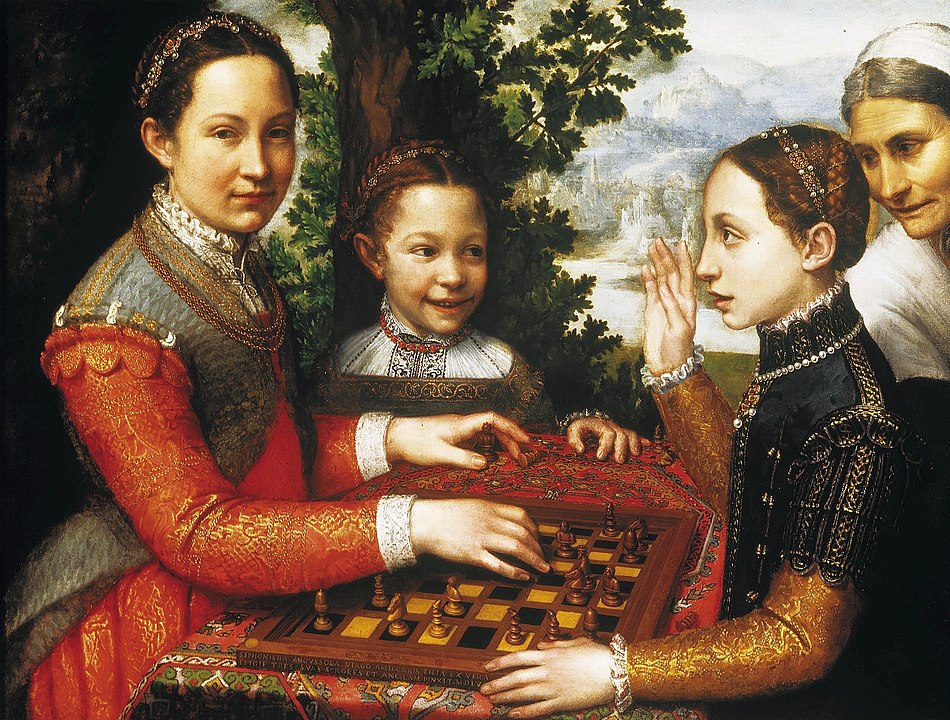 The Game of Chess, Sofonisba Anguissola, c. 1555
The Game of Chess, Sofonisba Anguissola, c. 1555Anguissola embarked on extensive travels during her career, with her time in Rome being particularly noteworthy. It was there that she had the privilege of meeting the esteemed Michelangelo, who was deeply impressed by her artistic talent. Throughout her artistic journey, she created numerous exceptional portraits, including the notable work 'The Game of Chess' (1555). This particular painting showcases her three sisters engaged in a game of chess within a garden setting. By depicting a domestic scene, Anguissola ventured into new artistic territory, as it was customary at that time to portray formal or allegorical subjects.
The absence of men in the composition of 'The Game of Chess' makes a lasting impression. Only the sisters and a maid are present, highlighting the idea that women can engage in highly intellectual pursuits. The depiction of the women playing chess signifies their ability to partake in something educationally enriching. Considering that chess is a game of power and strategy, the painting suggests that the sisters find enjoyment in the exercise of power and the elevated social status they possess through their own merits. It also symbolises the strength and unity found in sisterhood itself, amplifying the theme of female empowerment.
4. Agnolo Bronzino (1503-1572)
Bronzino, a renowned Mannerist painter from Florence, was not only an accomplished artist but also a poet. He spent his entire life in Florence, working in the shadow of the legendary Michelangelo. In the early stages of his career, Bronzino apprenticed under esteemed artists such as Raffaellino del Garbo and Jacopo Pontormo, honing his skills.
In 1539, Bronzino's talent garnered the attention of Cosimo I de' Medici's court, where he rose to the ranks of royal patronage. He was among the many artists entrusted with creating decorative pieces for the Duke's wedding.
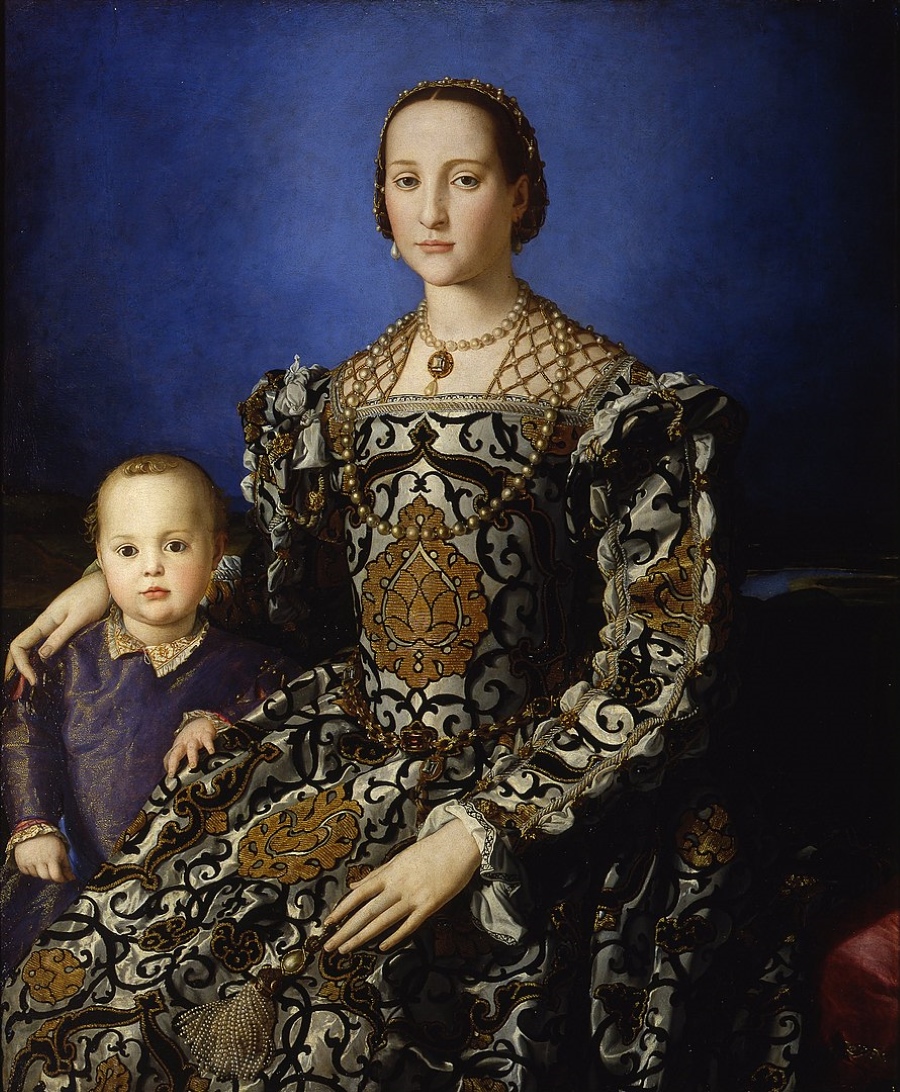 Portrait of Eleanor of Toledo and Her Son, Agnolo Bronzino, c. 1545
Portrait of Eleanor of Toledo and Her Son, Agnolo Bronzino, c. 1545Throughout his career, Bronzino produced numerous notable portraits and religious works, but one of his most influential pieces remains the 'Portrait of Eleanor of Toledo and Her Son' (c.1545). The painting portrays Eleanor of Toledo seated beside her son Giovanni against a dark blue backdrop. Notably, Eleanor's attire is intriguing, as she wears a grey dress adorned with intricate gold and black details, while maintaining a cool expression. Her son's outfit, though simpler, also features a golden collar detail. These visual elements serve to convey their power and wealth within the country, solidifying Eleanor's position as Cosimo Medici's wife. The portrait idealizes the status and influence of the women portrayed, offering a glimpse into the ideals of the time.
5. Rembrandt van Rijn (1606-1669)
Rembrandt van Rijn (1606-1669) was a celebrated Dutch Golden Age painter, printmaker, and draughtsman, acclaimed for his captivating portraits and self-portraits. A master of chiaroscuro, he skillfully employed the interplay between light and shadow to accentuate the features of his subjects. In nearly every portrait he created, the sitter's face harmoniously embraced the boundary between illuminated and shadowed areas, showcasing Rembrandt's exceptional command over this technique.
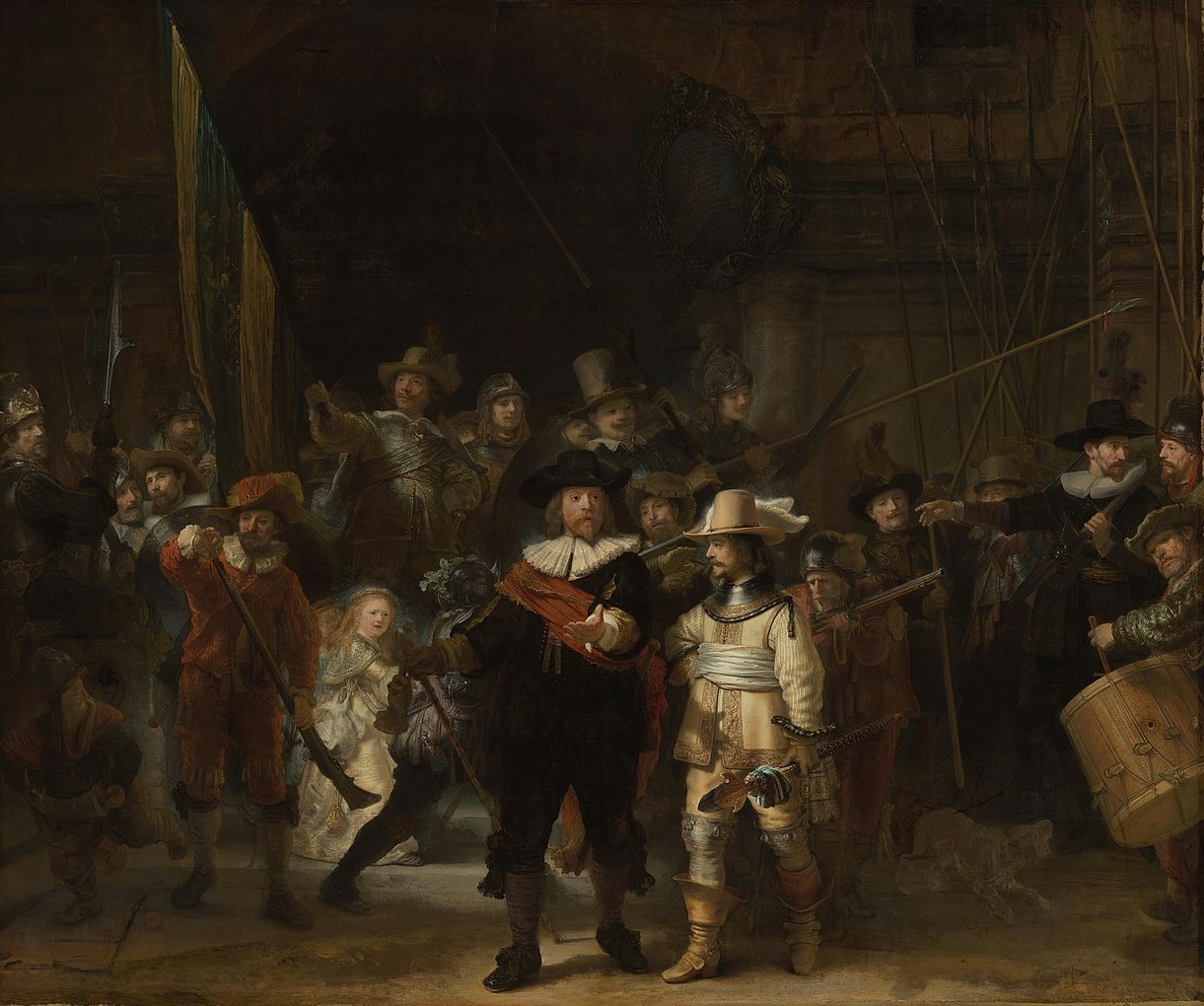 The Night Watch, Rembrandt van Rijn, c. 1642
The Night Watch, Rembrandt van Rijn, c. 1642Among Rembrandt's most renowned works is 'The Night Watch' (1642), a monumental group portrait depicting Amsterdam's civic militia, who valiantly defended the city from potential attacks. The captain, garbed in black attire, issues the order to march forth. Noteworthy in the painting is the use of lighting, which emphasises four figures, including the captain, by rendering them significantly lighter than the others. This deliberate choice brings these foreground figures to the forefront, capturing the viewer's attention. Additionally, the lighting grants an ethereal quality to the blonde girl, particularly accentuated by her white dress, evoking an angelic presence. The young girl serves as the symbolic mascot of the company. The painting exudes a sense of dynamism and movement, attributed to the guards' lively poses and actions captured within the composition.
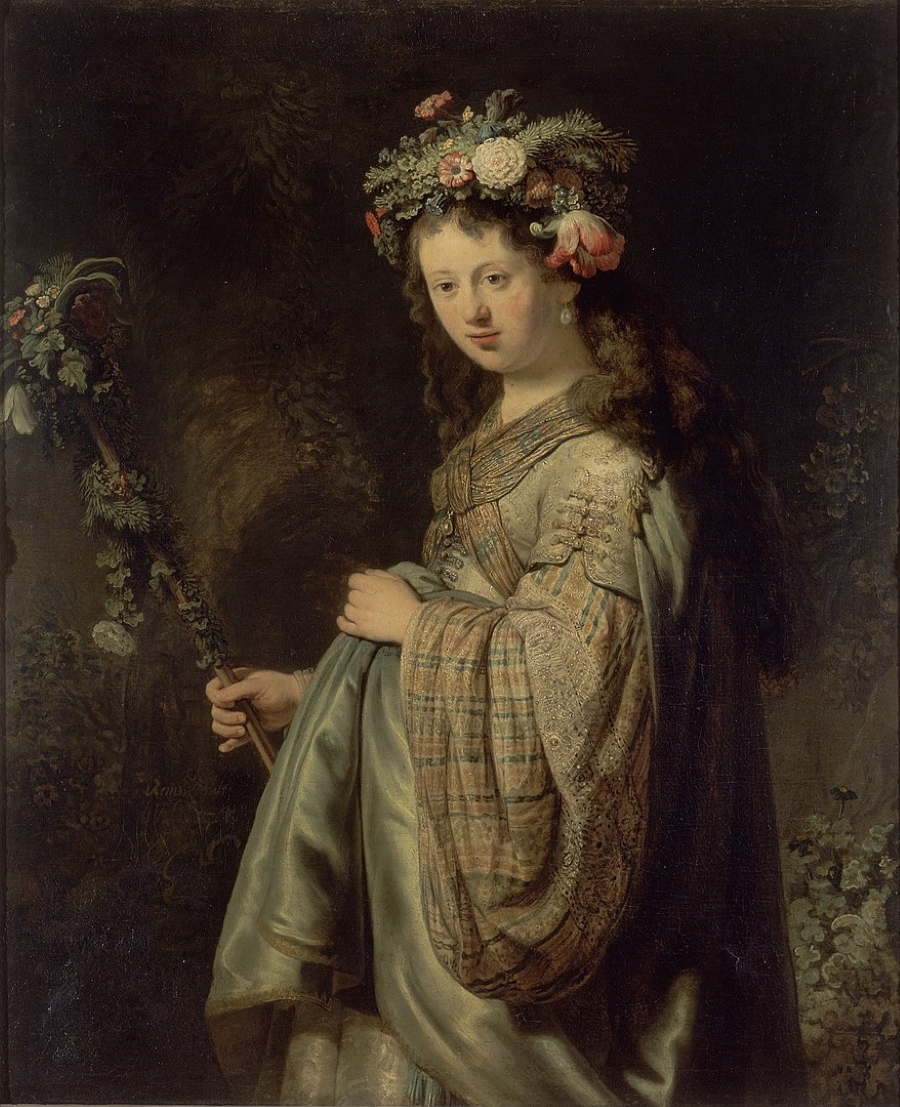 Saskia as Flora, Rembrandt van Rijn, c. 1634
Saskia as Flora, Rembrandt van Rijn, c. 1634Another of Rembrandt's remarkable works is 'Saskia as Flora' (1634), a portrait depicting his wife Saskia adorned as the Roman goddess of flowers. Tragically, Saskia passed away at the young age of 30, likely due to tuberculosis. The profound grief Rembrandt experienced following her death led to a prolonged hiatus in his artistic endeavours.
6. Diego Velázquez (1599-1660)
Along with Rembrandt, Spanish painter Velázquez was one of the leading Baroque artists. His style is rather individualistic and focused on Habsburg portraiture, and he was King Philip IV of Spain’s favourite court painter.
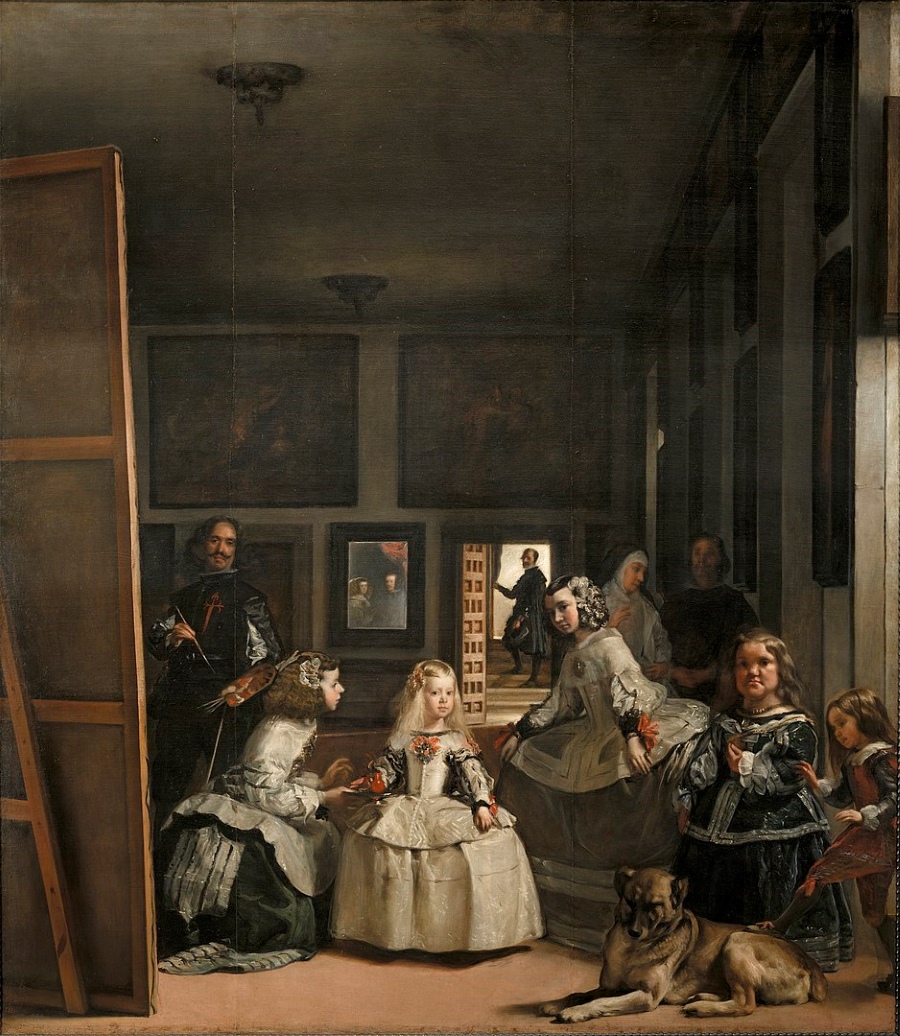 Las Meninas, Diego Velázquez, c. 1656
Las Meninas, Diego Velázquez, c. 1656His renowned masterpiece is ‘Las Meninas’, which he made in 1656 and which is one of the most important works of art at Madrid’s El Prado museum. This group portrait depicts an intriguing royal household scene, with the Infanta Margarita, the young princess of Spain, at the centre of the painting, surrounded by her entourage, maids, and various court figures. If you look at the mirror, you will see it reflects the faces of Philip IV and Mariana of Austria, the Infanta’s parents, who are watching the moment. This work is also Velázquez’s self-portrait, as he depicts himself in the corner of the painting, working on a large canvas.
 Portrait of Pope Innocent X, Diego Velázquez, c. 1650
Portrait of Pope Innocent X, Diego Velázquez, c. 1650Another of his striking portraits is ‘Portrait of Pope Innocent X’ (c.1650), which you can see at the Doria Pamphilj gallery in Rome. Velázquez did such a good job with portraying the pope that when the he saw the completed portrait of himself, the pope is said to have exclaimed:
Too real!
7. Angelica Kauffman (1741-1807)
Angelica Kauffman, a Swiss-born neoclassical painter renowned for her historical works and portraits, started working in her teenage years, having been trained by her father, the muralist Johann Joseph Kauffmann. She worked as her father’s assistant, travelling throughout Switzerland, Austria, and Italy.
She became famous in Italy and England, having been elected to the Roman Accademia di San Luca in 1765, and becoming one of the founders of the Royal Academy of Arts in London in 1768.
Kauffman travelled extensively throughout Europe during her career and in 1771, she visited Ireland, where she took on several commissions, including the portrait of Philip Tisdall, an Irish lawyer and politician.
 Portrait of the Irish lawyer and politician Philip Tisdall, Angelica Kauffman, c. 1770
Portrait of the Irish lawyer and politician Philip Tisdall, Angelica Kauffman, c. 1770The ‘Portrait of the Irish lawyer and politician Philip Tisdall’ (1770) depicts a lawyer posing with parchment next to a table with a mirror next to the parchment. Tisdall is at a three-quarter pose toward us. He is wearing a wig and black robe representing his job as a lawyer. The background is a rather neutral brown. The lighting of the piece settles on Tisdall's face, hands and mirror on the table, placing more attention on Tisdall and his work.
You can see the largest collection of her works at the Angelika Kauffmann Museum, in Schwarzenberg, Austria, which opened in 2007 in a historic Bregenzerwald house.
8. Berthe Morisot (1841-1895)
Berthe Morisot (1841-1895) was a prominent figure among the avant-garde Parisian painters who later became known as the Impressionists. Renowned for her ability to capture the essence of her day-to-day experiences, Morisot's paintings often depicted domestic scenes and offered a glimpse into the lives of women in 19th-century society—an aspect that differed from the public spaces typically portrayed by other artists of the time. As she progressed in her career, she explored subjects such as nudes and drew inspiration from the past.
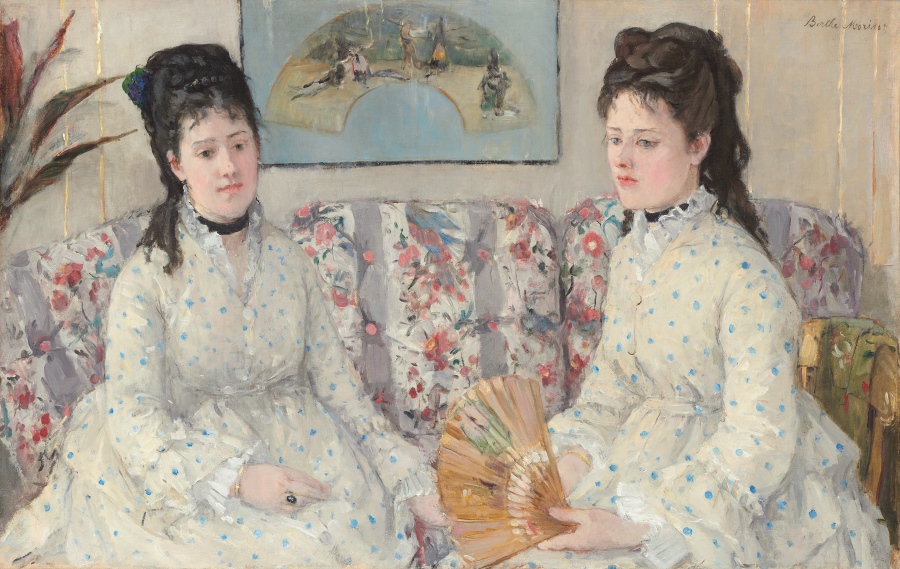 The Sisters, Berthe Morisot, c. 1869
The Sisters, Berthe Morisot, c. 1869Morisot frequently exhibited her impressionist pieces at the Salon de Paris under her full maiden name. Some of her notable works include 'The Sisters' (1869) and 'In the Dining Room' (1886).
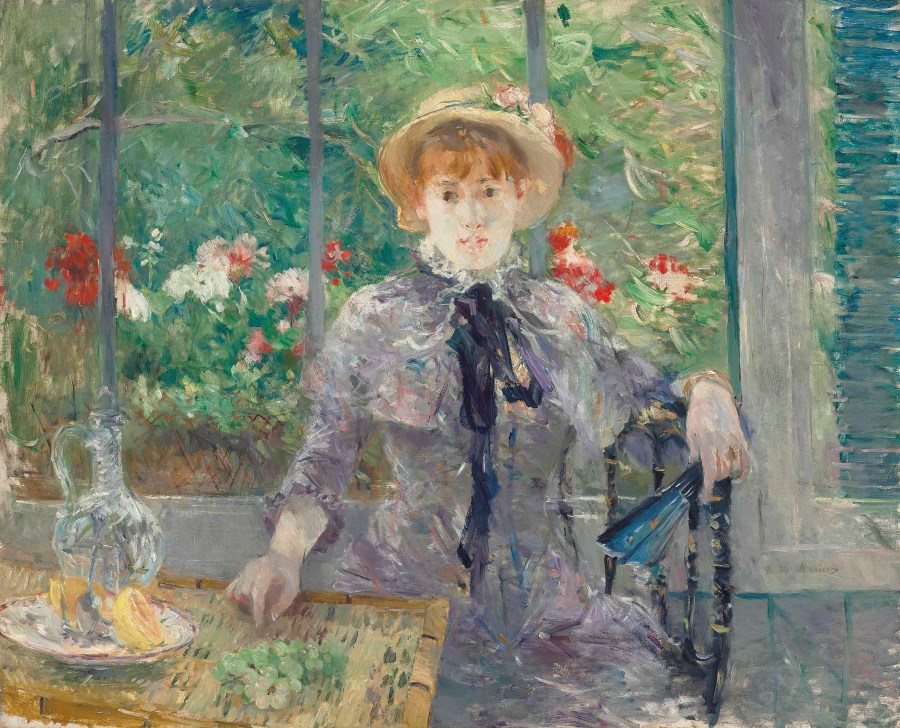 After Lunch, Berthe Morisot, c. 1881
After Lunch, Berthe Morisot, c. 1881One of her most famous paintings is 'After Lunch' (c.1881). This captivating artwork features a red-headed lady seated in a conservatory. The background is adorned with an abundance of flowers and a tree, which injects a vibrant burst of colour into the composition. The flowers' pale tones harmonise with the model's hat, while the model's dress appears almost translucent, subtly incorporating a similar blue tone found in the conservatory's woodwork around the edges. Notably, 'After Lunch' was sold at Christie's for a staggering £6.98 million, setting a world auction record for the Impressionist artist.
9. Valentin Serov (1865-1911)
Valentin Serov (1865-1911) was a notable Russian artist renowned for his exceptional talent in portraiture. In the early stages of his career, Serov focused on capturing the spontaneity of perception, particularly in his portrayals of models and nature. As time went on, he became associated with the Peredvizhniki (The Itinerants), a prominent group of Russian realist artists formed to challenge the academic restrictions of the time. This association allowed Serov to receive more significant and critical commissions, such as his renowned work 'The Portrait of Princess Olga Orlova' (c.1911).
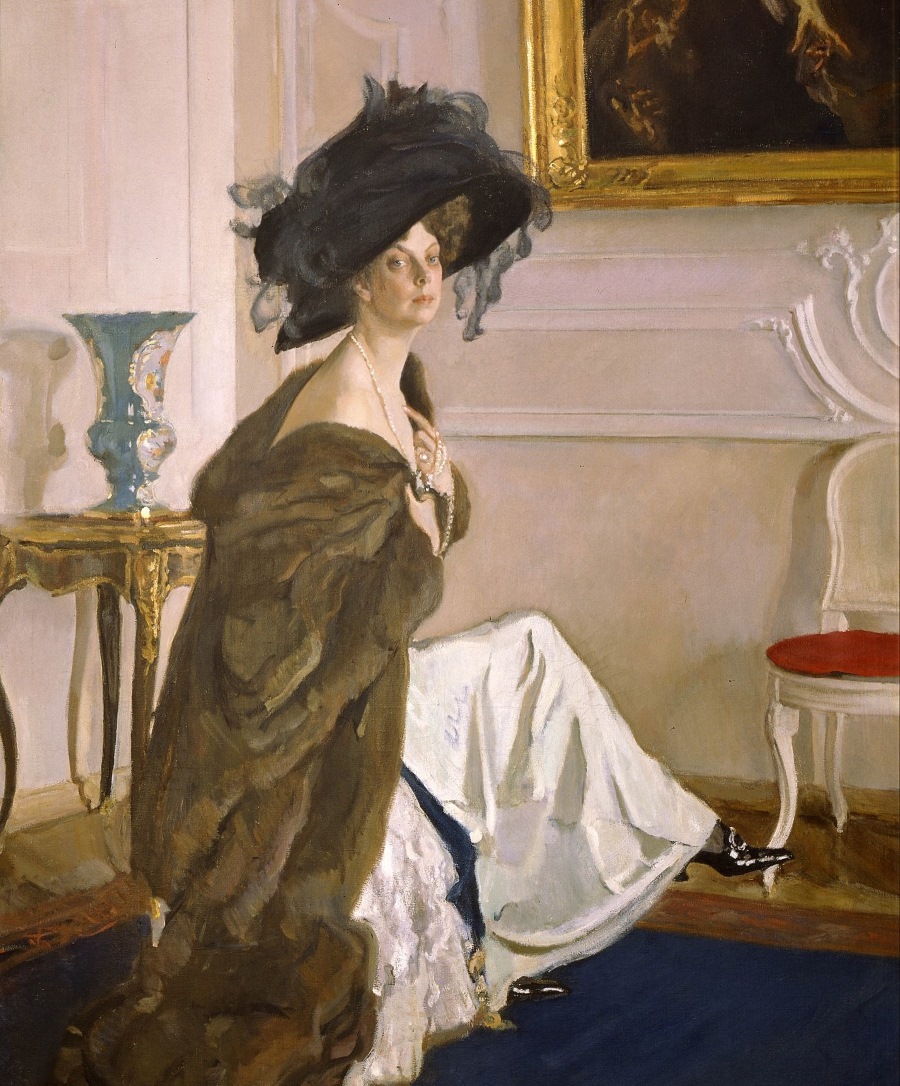 The Portrait of Princess Olga Orlova, Valentin Serov, c. 1911
The Portrait of Princess Olga Orlova, Valentin Serov, c. 1911In this portrait, Princess Olga is depicted within a stateroom, in an elegant dress while holding furs against her chest and gazing directly at the viewer. The painting exudes an air of elegance, emphasised by the piercing gaze of the princess. Serov expertly plays with light, creating a vibrant atmosphere with the brilliant whites of the dress and background. Through his mastery of light and composition, Serov captures the sophistication and pride associated with the world of wealth inhabited by Princess Olga.
As Serov's career progressed, he became associated with Mir Iskusstva (The World of Art), a significant avant-garde art community and movement in Russia. The period of the Russian Revolution of 1905-1907 brought about significant political and social upheavals, which also had an impact on artists. In 1905, Serov protested against the execution of striking workers and their families on Bloody Sunday by leaving the Russian Academy of Arts, reflecting his solidarity with the people's struggle.
10. Alice Neel (1900-1984)
Alice Neel, an American artist, made significant contributions by exploring women's experiences through the lens of the female gaze. Her works challenged the male gaze prevalent in art history, questioning traditional depictions of women, particularly in the context of nudes portrayed by male artists. Neel's paintings often centered around themes of motherhood, loss, and anxiety, influenced by the tragic death of her daughter shortly before her first birthday.
Neel's artistic career spanned from the mid-1920s until her death in 1984. Throughout this period, she continued to address feminist concerns and representations of the female body. One of her notable works is the 1980 nude self-portrait.
In this self-portrait, Neel employs straightforward backgrounds and shapes, ensuring that the viewer's attention remains focused on her body. The painting incorporates a fading blue outline that emphasises Neel's form, drawing the eye inward. Additionally, an orange shape beneath her foot anchors the composition and allows for the depiction of shadows adjacent to the green hue. The blue hues present in the chair and the faded blue of the outline establish a sense of visual harmony within the painting.
Alice Neel's art transcended societal norms, confronting the objectification of the female body and embracing the power of the female perspective. Her work continues to inspire discussions about gender, identity, and the representation of women in art.
Curious to discover more famous painters and how they shaped the history of art? Delve into how Frida Kahlo became a celebrated artist.
Photo credits: © Wikipedia Commons
